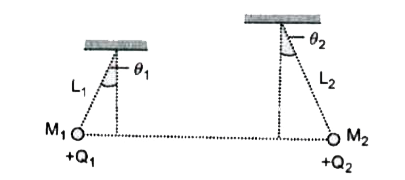An electron accelerated under a potential difference V volt has a certain wavelength λ. Mass of the proton is 2000 times the mass of the electron. If the proton has to have the same wavelength λ, then it will have to be accelerated under a potential difference of:Solution in Kannada
V volt
2000 V volt
V2000 volt
√2000 V volt.
The correct Answer is:C
λ=h√2meV, here mv=cost
∴200×V.=V×1⇒V.=V2000 Volt
Topper's Solved these Questions
- ELECTRONS & PHOTONSBOOK - MODERN PUBLICATIONCHAPTER - ELECTRONS & PHOTONSEXERCISE - MULTIPLE CHOICE QUESTIONS (LEVEL-III)
9 Videos
- ELECTRONS & PHOTONSBOOK - MODERN PUBLICATIONCHAPTER - ELECTRONS & PHOTONSEXERCISE - RECENT COMPETITIVE QUESTIONS
20 Videos
- ELECTRONS & PHOTONSBOOK - MODERN PUBLICATIONCHAPTER - ELECTRONS & PHOTONSEXERCISE - RECENT COMPETITIVE QUESTIONS
20 Videos
- ELECTROMAGNETIC WAVESBOOK - MODERN PUBLICATIONCHAPTER - ELECTROMAGNETIC WAVESEXERCISE - RECENT COMPETITIVE QUESTIONS
4 Videos
- ELECTROSTATICSBOOK - MODERN PUBLICATIONCHAPTER - ELECTROSTATICSEXERCISE - RECENT COMPETITIVE QUESTIONS
39 Videos
Similar Questions
Energy required for the electron excitation in Li++ from the first to the third Bohr orbit is :
View SolutionAccording to Einstein's photoelectric equation the graph of K.E. of the photoelectron emitted from the metal versus the frequency of the incident radiation gives a straight line graph whose slope
View SolutionAccording to Einstein's photoelectric equation the graph of K.E. of the photoelectron emitted from the metal versus the frequency of the incident radiation gives a straight line graph whose slope
View SolutionThe speed of electromagnetic wave in vacuum depends upon the source of radiation
View SolutionTwo small spheres of masses M1andM2 are suspended by weightless insulating threads of lengths L1andL2 The spheres carry charges Q1andq2 respectively . The spheres are suspended such that they are in level with one another and the threads are inclined to the vertical at angles of θ1andθ2 as shown . Which one o fthe following conditions , if θ1=θ2 ?

View SolutionA proton when accelerated through a potential difference of V volt has a wavelength lamda associated with it. An alpha-particle in order to have the same lamda must be accelerated through a potential difference of
View SolutionAn electron is accelerated through a potential difference of V volt. It has a wavelength λ associated must be accelerated so that its de Broglie wavelength is the same as the of a proton? Take mass of proton to be 1837 times larger than the mass of electron.
View SolutionAn electron of mass m when accelerated through a potential difference V has de - Broglie wavelength λ. The de - Broglie wavelength associated with a proton of mass M accelerated through the same potential difference will be
View SolutionAn electron accelerated under a p.d. Of V volt has a certain wavelength λ. Mass of the proton is 2000 times the mass of an electron. If the proton has to have the same wavelength λ, then it will have to be accelerated under p.d. of (volts)
View SolutionAn electron of mass m when accelerated through a potential difference V, has de Broglie wavelength λ. The de Broglie wavelength associated with a proton of mass M accelerated through the same potential difference, will be :-
View SolutionThe proton when accelerated through a potential difference of V volt has a wavelength lamda associated with it. If an alpha -particle is to have the same wavelength lamda , it must be accelerated through a potential difference of
View SolutionAn electron is accelerated through a potential difference of V volt. It has a wavelength λ associated with it. Through what potential difference an electron must be accelerated so that its de Broglie wavelength is the same as that of a proton? Take massof proton to be 1837 times larger than the mass of electron
View SolutionAn electron accelerated under a potential difference of V volt has a certain wavelength lamda It is known that the mass of a proton is about 1800 times the mass of an electron . If a proton has to have the same wavelength lamda , then it will have to be accelerated under the potential difference of
View SolutionAn electron of mass m, when accelerated through a potential difference V, has de Broglie wavelength λ. The de Broglie wavelength associated with a proton of mass M, accelerated through the same potential difference, will be
View SolutionAn electron of mass m, when accelerated through a potential difference V, has de-Broglie wavelength λ, the de-Broglie wavelength associated with a protom of mass M and accelerated through the same potential difference V will be
View Solution
